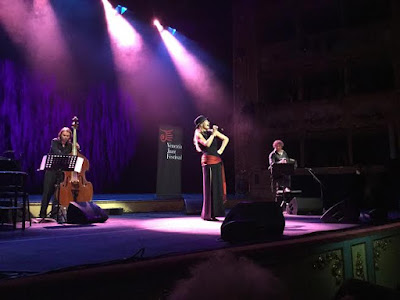 |
| Chief James Billie (center) with Hard Rock Cafe staff in Venice |
Chief Billie's mother belonged to the Bird clan; his father was was a white sailor who went to Europe during WWII without knowing of the pregnancy. As an infant, Seminole medicine men wanted to kill Jim Billie the traditional way -- by stuffing mud in his mouth and leaving him to die in the Florida Everglades -- because he was a half-breed. His mother, Agnes Billie, who died when he was nine, and Betty Mae Tiger Jumper, another half-breed -- who went on to become the first and only tribal chairwoman -- put a stop to it. To earn money, Jim Billie went on to wrestle alligators for tourists, as well as build chickee huts.
 |
| Chickee hut at Big Cypress Indian Reservation |
When the money started gushing in, Chief Billie became a thorn in the side of the Florida government and big business, insisting on behaving like a Native American by refusing to put toxic dumps and landfills on Seminole land, and being uncooperative about pipelines, flight paths, roads and telephone towers. No American Indian has been more investigated by the US government than Chief Billie-- including the FBI and the IRS -- yet no agency has brought a single criminal charge against him.
When he started to criticize his fellow councilmen's spending habits, and brought in an outside administrator, Chief Billie rankled the Seminole ranks, who began to block him. However, what actually brought him down was a woman scorned, who later said she had been coerced into filing suit against Billie for sexual misconduct by other Seminole leaders. Chief Billie was impeached by the Seminole Council in 2001, and started, once again, to build thatched chickee huts in South Florida, waiting for his opportunity to make a comeback.
 |
| Hamish Dodds, Chief Billie & Pablo Castrogiovanni - Hard Rock Cafe, Venice |
 |
| Cat Bauer with Seminole Chief Billie at Hard Rock Cafe, Venice |
As President and CEO of Hard Rock International, Hamish Dodds, a Scotsman, oversees all aspects of the global enterprise, and is responsible for strategic development. Previously, he worked as CEO for Cabcorp, and then in the upper ranks of PepsiCo. He said that Italy was a very, very important market for Hard Rock, and spoke of the passion the Seminole owners have for their own brand. Dodds said that it was not easy to do business in Italy, but that he thought that Prime Minister Matteo Renzi was trying to make it easier.
 |
| Ca' Vendramin Calergi - Home of Venice Casinò |
At that point I was bursting with excitement -- I had come to the conference hoping for the opportunity to discuss just that topic, and here the CEO of Hard Rock was presenting it himself! To me, if the Hard Rock transformed the casino by the airport into a Hard Rock Casino, yet was behind the scenes at Ca' Vendramin Calergi, it would bring much needed wealth and positive energy to Venice. Venetians and Seminole Indians under the leadership of Chief James E. Billie are a good fit. I THINK THIS IS A FANTASTIC IDEA.
 |
| Seminole Indians at Hard Rock Cafe, Venice |
Several times Chief Billie said how grateful and thankful he was. He taught us the Seminole word "Sho Na Bish," which means "thank you," and wants to put that on all the Hard Rocks, too, in addition to the LOVE ALL - SERVE ALL put there by Issac Tigrett.
When the conference was over, Hamish Dodds said that anyone -- the press, the employees, the kitchen staff, anyone -- could ask them anything. He was immediately interrupted and told that a list of questions had already been prepared. He responded that it would lose the spontaneity, but acquiesced. They were then asked several innocuous questions by the translator; for example, to Chief Billie: 'Why do you think the word "Hard Rock" is so successful, and what do you like about it?" To which he replied, "You can probably answer that yourself," and then went on to say it was a romantic word, a sexy word.
 |
| Maria, Chief Billie's wife, and Cat Bauer |
Chief Billie ended the conference by saying that back when the Seminole used to fight the military that they called themselves the unconquered, and that he had discovered that Venetians call themselves unconquered, too. Then he exclaimed: "Sho Na Bish!"
From the press notes:
With a total of 202 venues in 64 countries, including 154 cafes, 21 hotels and 10 casinos, Hard Rock International is one of the most globally recognized companies. Beginning with an Eric Clapton guitar Hard Rock owns the world's greatest collection of music memorabilia, which is displayed at its locations around the globe.
Visit www.hardrock.com for more information.
Ciao from Venezia,
Cat Bauer
Venetian Cat - The Venice Blog




















